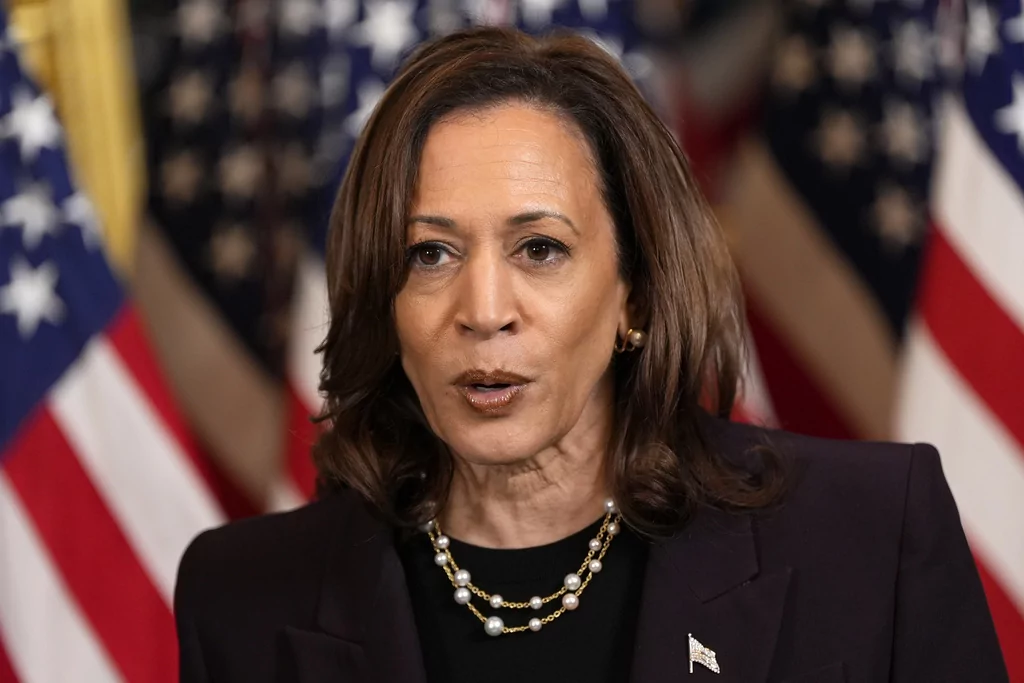

Kamala’s path to victory
Democrats’ shiny new object in the form of a new presidential candidate has been a boon. Vice President and presidential candidate Kamala Harris is boasting historic fundraising numbers, hauling in $80 million in her first 24 hours and $124 million in less than a week. Voters are excited to turn out for rallies and sign up to help her campaign operations. The doom and gloom of heading into a 2020 rematch with an aging President Joe Biden stretching out his bridge candidacy has been replaced with a run-and-gun political offense that makes the party in power feel like it’s back in the game.
However, for all the excitement, it’s not yet clear whether Harris is so much better than Biden that Democrats have a chance to win in November. Her ties to the administration mean most of his problems are hers, and while new polling from the New York Times-Siena College shows her within 1 point of former President Donald Trump among likely voters, the 2024 contest is still set to be played out in a handful of swing states where Republicans continue to hold the upper hand.
White House Reporter Naomi Lim went through the early polling we have of experts in the field asking voters their feelings about a Trump-Harris matchup versus a Trump-Biden one that had vulnerable Democrats despondent that Trump was on a glide path to victory — and that they were just fine with that.
In a campaign memo from Chairwoman Jen O’Malley Dillon this week, Harris’s team announced it hadn’t switched its focus from the “blue wall states of Michigan, Wisconsin, and Pennsylvania — and the Sun Belt states of North Carolina, Georgia, Arizona, and Nevada, where the vice president’s advantages with young voters, black voters, and Latino voters will be important to our multiple pathways to 270 electoral votes.”
“In a separate briefing this week, Priorities USA, the Democratic Party’s largest super PAC, shared its first ‘snake chart’ with Harris and Trump, a graphic that ranks the states they are most likely to win so the battlegrounds are in the middle,” Naomi wrote. “That chart considered Michigan, Nevada, Pennsylvania, Wisconsin, and Nebraska‘s 2nd Congressional District to be toss-ups, with Trump likely to win Arizona and Georgia.”
“We’re focused in our work specifically on Michigan, Wisconsin, Pennsylvania, which we have in this forecast as the tipping point state, Nevada, and Arizona,” Priorities USA Deputy Executive Director Nick Ahamed said. “As we’re thinking about our investments across the five states and updating our resource allocation, it’s looking exactly the same as it was last week.”
Harris made Wisconsin, formerly Biden’s best swing state chance and the home of the Republican National Convention, her first campaign stop this week.
Next week, she is scheduled to travel to Atlanta, Georgia, to try to appeal to voters who helped push her and Biden over the edge four years ago but appear to be returning to their Republican roots.
Anyone can try their hand at political strategy with 270 to Win’s interactive map. However, when gaming out which states might lean, flip, or hold steady, it’s clear that Harris’s path to victory is a narrow one that, University of Virginia’s Kyle Kondik told Naomi, is nonexistent unless she picks up Michigan, Pennsylvania, and Wisconsin.
“I would still be surprised if Harris could win if she lost any of Michigan, Pennsylvania, or Wisconsin,” Kondik told the Washington Examiner. “That said, one thing I am looking for is whether polling points to a different road. Generally speaking, Biden had been holding up better in the Industrial North than the Sun Belt. Does Harris change this at all?”
Click here to see what we know about how Harris fares in the swing states.
SCOTUS pocus
There are few things Biden will be able to do with his lame-duck status in the final five months of his 52-year career in public office. Democrats have been touting his record as president, with Harris telling voters on the trail that Biden has accomplished more in four years than most presidents do in eight.
He told the country on Wednesday night that he thought his record merited a second term. That speech also gave the country a glimpse of what he plans to try to accomplish before exiting the stage.
After running as a centrist in 2020, Biden slowly but surely adopted the policies advocated by the left wing of his party. Forgiving student loans was a promise he made before he got into office, and the Inflation Reduction Act was a type of Green New Deal plan focused on investing huge sums into climate goals while calling the spending something else.
However, the crown jewel of the Democratic Party’s hard-left wing is to institute sweeping changes to the Supreme Court, something Biden has recently said he supports.
The problem, Senate Reporter Ramsey Touchberry wrote for us today, is that senators aren’t sure what Biden’s plans are, and anyone who has been in touch with the White House isn’t talking about what is coming down the pike.
“The White House is keeping its work on proposed changes to the Supreme Court under wraps from key Senate Democrats even as some seek to offer their two cents on policies they would play a crucial role in passing during President Joe Biden’s final months in office,” Ramsey wrote. “Several Democrats on the Senate Judiciary Committee surveyed by the Washington Examiner said they have not heard from the White House on the matter despite weeks of reports on the subject, including panel Chairman Dick Durbin (D-IL).”
“I haven’t heard anything directly from the White House,” said Durbin, the chamber’s second-ranking Democrat as majority whip.
Democrats have been frustrated with the Supreme Court for close to a decade, when then-Senate Majority Leader Mitch McConnell (R-KY) refused to hold a hearing for Attorney General Merrick Garland, who had been nominated to take the seat of Justice Antonin Scalia.
Outrage ensued when the court ruled nominally in favor of Trump when it said presidents enjoy broad immunity for actions taken while they’re in office.
Sandwiched between those events were Democratic attacks on Justices Clarence Thomas and Samuel Alito for trips taken, gifts received, and flags flown that enraged the Left and spurred demands for a code of ethics to govern the behavior of the justices.
All of those incidents hint at some of the things Biden and Senate Democrats might try to push through in the closing days of his administration.
“Biden’s work-in-progress proposal reportedly includes endorsing term limits for justices and a legally enforceable ethics code, which would take precedence over the high court’s self-imposed ethics pledge,” Ramsey wrote. “The prospects of such measures becoming law in a divided Congress are virtually zero, but the legislation would energize Democrats’ base just months before the election.”
“Other Democrats not on the Judiciary Committee, such as Sen. Ed Markey (D-MA), want the party to go far further by packing the high court with four new justices,” he wrote.
Click here to read more about Biden’s supreme plans for the court.
Valuable valley votes
Tech bros and venture capitalists in Silicon Valley aren’t typically targets for Republicans. There are exceptions, but the techies and moguls in California are reliably Democratic voters and donors.
However, the sea of cash sloshing around on the Pacific Coast that Democrats have enjoyed might dry up after their latest aspirational messaging plans are sending up flares for the incredibly wealthy and ambitious Northern California crowd.
Economics and Business Reporter Zachary Halaschak took a look at the trouble Democrats could find themselves in and the boon Republicans might be preparing for because lofty plans about a wealth tax are spooking Silicon Valley.
“Some have cited President Joe Biden’s proposal to tax the unrealized capital gains of the wealthiest people as the breaking point. It is a largely aspirational plan designed to appeal to the progressive wing of the Democratic Party, but one which appears to now be a major reason that the tech elite are jumping ship,” Zachary wrote. “The plan, first outlined in 2023, would impose a 25% minimum tax on the total income of those with assets greater than $100 million.”
Plans for a wealth tax might not be new, or even be at the front of Democrats’ messaging right now, as they have been consumed with ousting and replacing their standard-bearer. But venture capitalists Marc Andreessen and Ben Horowitz are watching their bank accounts and the political moves that could sap them. The two spoke on a podcast this month about the “very scary” plans that are pushing them to back Trump in November.
“If you’re a venture firm, you’re getting strips of your portfolio pulled away from you every year. … This makes startups completely implausible because why on earth is anybody going to go do this instead of going to go work for Google and getting paid a lot of money every year in cash,” Andreessen said.
“The proposal, if it were to ever actually become law, is a massive departure from the current tax regime because gains would be taxed even if not realized,” Zachary wrote. “Under the existing tax code, billionaires and the very wealthy whose investments increase in value are taxed on that growth, known as capital gains, when those investments are finally sold off.”
Previous attempts to pass a wealth tax ran into immediate opposition from Republican and centrist Democratic lawmakers. The idea is a relatively popular one among voters, but the logistics of changing the tax code are fraught with problems, and there is a question of the constitutionality of levying the tax.
Experts Zachary spoke with said the wins Republicans could pick up now aren’t necessarily indicative of how the tech world is going to respond in the future but that Democrats also can’t write off the concerns expressed now, especially with Trump allying with a former venture capitalist who is an acolyte of Peter Thiel in his race to reclaim the White House.
Click here to read more about the slippery slope that has Silicon Valley panicked.
New from us
Kamala Harris creates small opening for a Nikki Haley comeback
Public assistance cannot keep you healthy
Anti-abortion Catholics breaking with JD Vance over abortion pill comment
Barack and Michelle Obama endorse Kamala Harris’s presidential campaign
Kamala Harris locks down teachers union endorsements as she embraces left-wing education activism
In case you missed it
Mike Johnson is staking out Harris’s home state
A letter and Oval Office address weren’t enough to satisfy White House reporters
Trump is not so sure he wants to debate Harris
For your radar
There are no public appearances for Biden or Harris.






